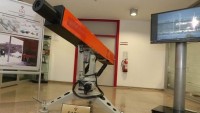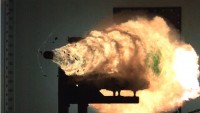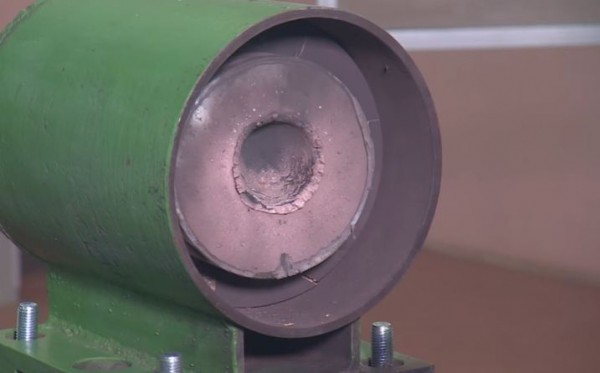Russia Conducts Another Test Firing of its Electromagnetic Railgun
| Arthur Dominic Villasanta | | Jan 11, 2017 05:20 AM EST |
(Photo : Russian Academy of Sciences ) Effect of the impact of a plastic bullet fired by a Russian railgun during a test in 2016.
Russia's baby steps to develop its own electromagnetic railgun took another baby step forward with the announcement of another successful test firing of the weapon, but this time at far lower speed.
Scientists at a branch of the United Istitute of High Temperatures at the Russian Academy of Sciences (RAS) outside Moscow fired a 15 gram plastic bullet that penetrated an aluminum plate several centimeters thick. The railgun developed a speed of 3 kilometers per second, which the Russians said is powerful enough "to cut through any type of armor existing today."
Like Us on Facebook
The Russians also claim their railgun will have non-destructive uses such as shooting cargo capsules to the International Space Station.
In contrast, the United States, which leads the world in the military applications of railgun technology, has built far more powerful and larger weapons.
The U.S. Navy has railgun cannons that can fire hypervelocity projectiles at speeds up to Mach 7.5 (9,100 km/h) to a distance of some 400 kilometers.
"The railgun is a big boost to our study of high energy physics as we are now ready to build apparatuses working at speeds exceeding 4.5 kilometers a second," said Alexei Shurpov, director of the Shatura Institute.
The Russians, however, admitted their railgun program has not produced any military breakthroughs yet. They did note that other countries are working on a new type of a multi-mission railgun capable of detecting, tracking and engaging ballistic missiles and air and watercraft threats.
They said the problem with U.S. railgun design is it requires a tremendous amount of power to operate, over 25 megawatts per shot.
Another problem is that the longer the distance to the target, the weaker the impact of railgun round as air resistance keeps slowing the projectile down as it travels to its target.
The Russians first tested their railgun in July 2016, also at Shatura.
The team reported firing projectiles at a velocity of 11 kilometers per second, enough to overcome gravity and reach Earth orbit. RAS President Vladimir Fortov said the railgun will help Russian scientists study matter at extremely high temperatures and pressure and understand how the Universe is organized.
The railgun fired a projectile weighing 2 grams at a velocity of 3.2 km/s. Russian scientists are preparing the railgun to fire projectiles exceeding hypersonic speeds, or speeds in excess of Mach 5 (6,000 km/h).
TagsRussia, electromagnetic railgun, United Istitute of High Temperatures, Russian Academy of Sciences, U.S. Navy
©2015 Chinatopix All rights reserved. Do not reproduce without permission
 US Railguns Being Upgraded to Destroy Supersonic Missiles
US Railguns Being Upgraded to Destroy Supersonic Missiles Turkey Unveils Prototype Electromagnetic Railgun for New Navy Destroyers
Turkey Unveils Prototype Electromagnetic Railgun for New Navy Destroyers US Navy to use Hypervelocity Projectiles to Shoot Down Chinese and Russian Anti-Ship Missiles
US Navy to use Hypervelocity Projectiles to Shoot Down Chinese and Russian Anti-Ship Missiles Russia Tests its first EM Railgun but will use it to Study the Universe
Russia Tests its first EM Railgun but will use it to Study the Universe US Army to Receive Railgun Artillery Howitzers in 2019
US Army to Receive Railgun Artillery Howitzers in 2019 Pulse Power Systems that Fire Electromagnetic Railguns Delivered to U.S. Navy
Pulse Power Systems that Fire Electromagnetic Railguns Delivered to U.S. Navy
EDITOR'S PICKS
-

Did the Trump administration just announce plans for a trade war with ‘hostile’ China and Russia?
-

US Senate passes Taiwan travel bill slammed by China
-

As Yan Sihong’s family grieves, here are other Chinese students who went missing abroad. Some have never been found
-

Beijing blasts Western critics who ‘smear China’ with the term sharp power
-

China Envoy Seeks to Defuse Tensions With U.S. as a Trade War Brews
-

Singapore's Deputy PM Provides Bitcoin Vote of Confidence Amid China's Blanket Bans
-

China warns investors over risks in overseas virtual currency trading
-

Chinese government most trustworthy: survey
-

Kashima Antlers On Course For Back-To-Back Titles
MOST POPULAR
LATEST NEWS
Zhou Yongkang: China's Former Security Chief Sentenced to Life in Prison

China's former Chief of the Ministry of Public Security, Zhou Yongkang, has been given a life sentence after he was found guilty of abusing his office, bribery and deliberately ... Full Article
TRENDING STORY

China Pork Prices Expected to Stabilize As The Supplies Recover

Elephone P9000 Smartphone is now on Sale on Amazon India

There's a Big Chance Cliffhangers Won't Still Be Resolved When Grey's Anatomy Season 13 Returns

Supreme Court Ruled on Samsung vs Apple Dispute for Patent Infringement

Microsoft Surface Pro 5 Rumors and Release Date: What is the Latest?










